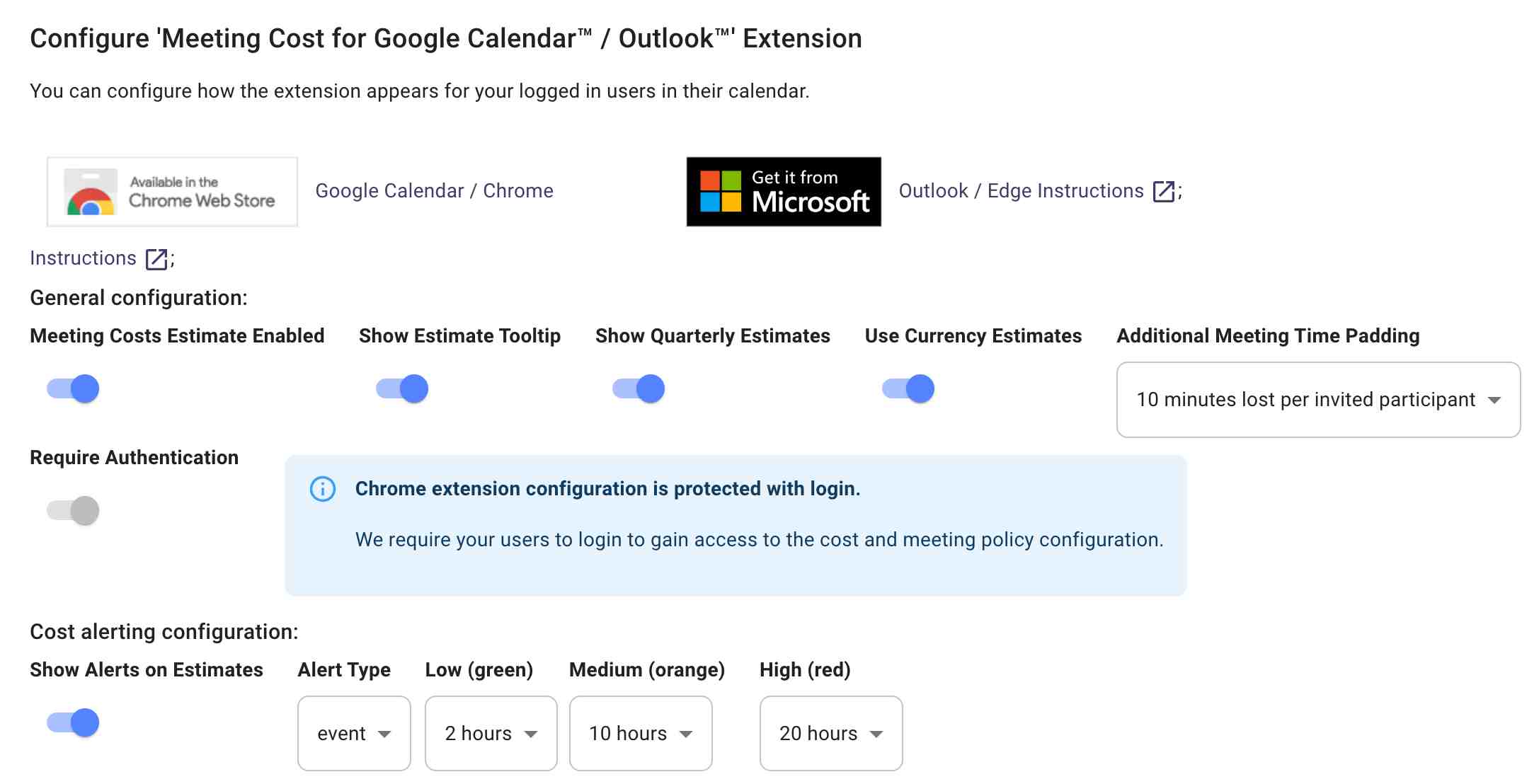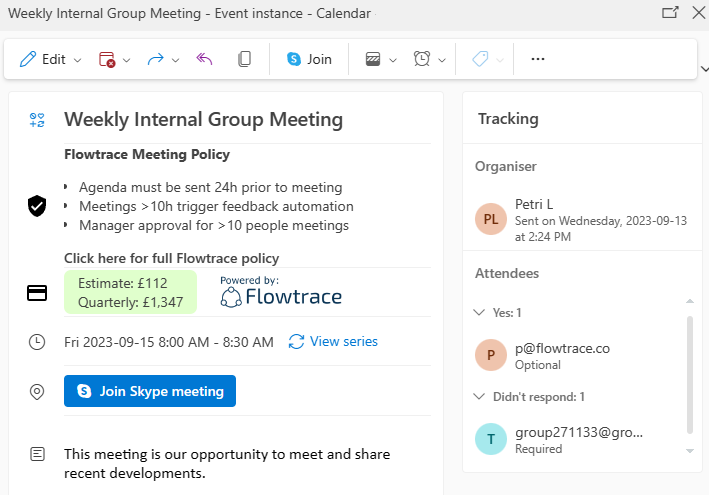Add Meeting Costs to Outlook™
Flowtrace Meeting Analytics: 'Meeting Costs for Microsoft Outlook', an Outlook Add-in for tackling 'meeting overload' as seen @ Shopify.
Discover how Shopify's Meeting Cost Calculator is revolutionizing meeting culture and explore similar solutions like Flowtrace.
In any business setting, meetings play a huge role when it comes to collaboration and decision-making. However, they can also cause persistent issues that are often overlooked —unnecessary meetings that drain time and resources. There is however a solution that can help manage this; meeting cost calculators, innovative tools designed to optimize collaboration.
In this context, Shopify's Meeting Cost Calculator highlights the need and effectiveness of a tool like this. It assigns a tangible cost to meetings, aiming to prevent needless gatherings. In this article, we explore this tool's mechanics and its impact on productivity and meeting culture. We'll also touch on similar solutions like Flowtrace's meeting cost calculator extension, offering an accessible solution that can shift your approach to meetings for intentional collaboration and increased productivity.
Intending to optimize productivity and streamline collaboration, Shopify has developed a groundbreaking tool known as the Meeting Cost Calculator. This innovative solution aims to tackle a common challenge leaders face; the increase in unnecessary meetings that drain resources in terms of time and finances.

Shopify's Meeting Cost Calculator is an internal tool designed to provide tangible insights into the financial impact of meetings within the organization. It seamlessly integrates with Google Calendar and, when activated, estimates the cost associated with any meeting involving three or more attendees.
Shopify's Meeting Cost Calculator operates on a straightforward yet powerful methodology. It estimates the financial impact of each meeting by factoring in two key variables:
These calculations result in a tangible cost estimation that provides organizers and participants with a clear understanding of the financial resources invested in each gathering.
Shopify's decision to develop the Meeting Cost Calculator was to deal with unnecessary meetings that were occurring within the organization. While meetings are essential for collaboration and decision-making, unchecked, they can become a drain on valuable time and resources.
The company recognized that the average size of its meetings comprised three individuals, with an average duration of 30 minutes. This translated to a typical cost ranging from $700 to $1600. Notably, costs increased with additional attendees or the presence of high-level executives.
In any organization, meetings play a pivotal role in collaboration, aligning teams, and making critical decisions. However, Shopify, like many companies, recognized the problem of unnecessary meetings that could stifle productivity and drain valuable resources.
Unnecessary meetings at Shopify posed a significant threat to the company's productivity and collaboration efforts. These gatherings had several adverse effects:
To comprehend the extent of this issue, Shopify examined various aspects of its meeting culture. Statistical insights and examples were essential in highlighting the problem:
Recognizing the extent of the situation, Shopify decided to take a proactive stance. In January, they introduced a bold initiative—the cancellation of recurring meetings involving more than three people. Additionally, they implemented the "Chaos Monkey" meeting policy, which encouraged employees to assess the necessity of meetings and cancel them if found redundant.
Shopify witnessed tangible results with the decision to cancel unnecessary meetings:
Shopify's strategic decision to address unnecessary meetings head-on not only optimized the allocation of time and resources but also promoted a culture of intentional collaboration.
Understanding how Shopify calculates meeting costs is essential in understanding and appreciating the precision and effectiveness of their Meeting Cost Calculator.
What sets Shopify's Meeting Cost Calculator apart is its ability to tailor cost estimates to each unique meeting. To achieve this level of accuracy, Shopify incorporates comprehensive data spanning various roles and departments within the organization.
This detailed compensation data allows the tool to assign appropriate financial values to participants based on their positions and responsibilities. For instance, the cost associated with a senior executive's presence in a meeting is significantly higher than that of a junior team member.
By factoring in this compensation data, Shopify's Meeting Cost Calculator provides a nuanced and precise cost estimation, reflecting the true financial impact of meetings on the organization.
Shopify's Meeting Cost Calculator recognizes that not all attendees are created equal in terms of their financial impact on meetings. Attendee types vary, and costs are adjusted accordingly:
By considering the role-based compensation data and attendee types, Shopify's Meeting Cost Calculator offers a detailed understanding of how meetings impact the organization financially.
The Meeting Cost Calculator at Shopify initiated a 'meeting culture' shift. It prompted employees at all levels to reconsider the way they approached meetings. Instead of viewing meetings as routine events, the tool emphasized that each gathering had a tangible cost—a cost that was no longer concealed but open for all to see.
One of the key lessons instilled was the importance of intentionality in meeting planning. As employees began to realize the financial implications of their meetings, they became more deliberate in their decision-making. Questions like "Is this meeting necessary?" and "Do all these participants need to be here?" became common.
This shift in mindset encouraged teams to streamline their meetings, ensuring that each gathering had a clear agenda and purpose. As a result, meetings became more focused, efficient, and productive. Attendees were no longer dragged into gatherings that did not directly contribute to their roles or the company's goals.
Complementing the Meeting Cost Calculator, Shopify introduced the 'Chaos Monkey' meeting policy. While it didn't ban meetings outright, it encouraged employees to critically assess recurring meetings involving more than three people. This policy served as a powerful deterrent against unnecessary gatherings and reinforced the company's commitment to intentional collaboration.
The 'Chaos Monkey' policy acted as a check-and-balance mechanism, ensuring that meetings were conducted with a clear purpose and that the costs associated with them were justified. It empowered employees to challenge the status quo and make data-driven decisions about their meeting schedules.
Flowtrace's Meeting Cost Calculator for Google Calendar is designed to provide managers with a clear understanding of the financial implications of their meetings as they are scheduled.

This innovative solution automates the process of estimating the cost of meetings directly within Google Calendar. It integrates seamlessly with Flowtrace meeting analytics, enhancing its functionality by utilizing advanced analytics to offer accurate and comprehensive cost estimates.
Using meeting costs for Google can open up detailed cost estimates for both direct and group-invited meetings, ensuring a thorough understanding of meeting expenditures. Managers can effortlessly track meeting costs, leading to more informed decisions about how they allocate time and resources, ultimately fostering a more cost-effective and productive meeting culture.
The setup process is straightforward and user-friendly. Users simply need to install the extension and log in using their Google account to access the customized organizational cost configurations.

Flowtrace’s Meeting Cost Calculator for Outlook mirrors the utility and effectiveness of its counterpart for Google Calendar, tailored for the Microsoft Outlook environment. This tool is designed to provide an automated, precise calculation of the costs associated with meetings scheduled in Outlook.
Key features include the automated cost calculation which simplifies the process of assessing the financial impact of each meeting scheduled in Outlook. This feature works in conjunction with the rest of the analytics, ensuring that cost estimates are not only accurate but also contextually relevant to the organization's specific needs.
The integration of meeting costs for Outlook with Flowtrace meeting analytics means users get a detailed, data-driven understanding of meeting costs, enhancing the decision-making process related to meeting management and resource allocation.
One of the key advantages of integrating Flowtrace into your company culture is its ability to complement Shopify's Meeting Cost Calculator:

Effective meeting management is crucial for management and senior leadership to create an efficient meeting culture within the organization:
By adhering to these best practices and considering the accessibility of tools like Flowtrace, management, and senior leadership can promote a culture of intentional and effective meetings. Whether through internal tools or accessible solutions, the goal is the same: to optimize collaboration, enhance productivity, and maximize the value of every meeting within the organization.
Understanding meeting cost calculators, from Shopify's efforts to Flowtrace's pioneering solutions, underscores the importance of reducing unnecessary meetings and calculating their costs. By promoting a culture of intentionality and leveraging tools like Flowtrace, organizations can enhance productivity and collaboration, align resources strategically, and unlock greater value.
Flowtrace Meeting Analytics: 'Meeting Costs for Microsoft Outlook', an Outlook Add-in for tackling 'meeting overload' as seen @ Shopify.
Optimize meetings with these meeting cost plugins for Google Calendar and Microsoft Outlook. Gain real-time cost insights to schedule smarter and...
Calculate meeting costs with this interactive meeting cost calculator giving you an accurate representation of how much money your meetings are...